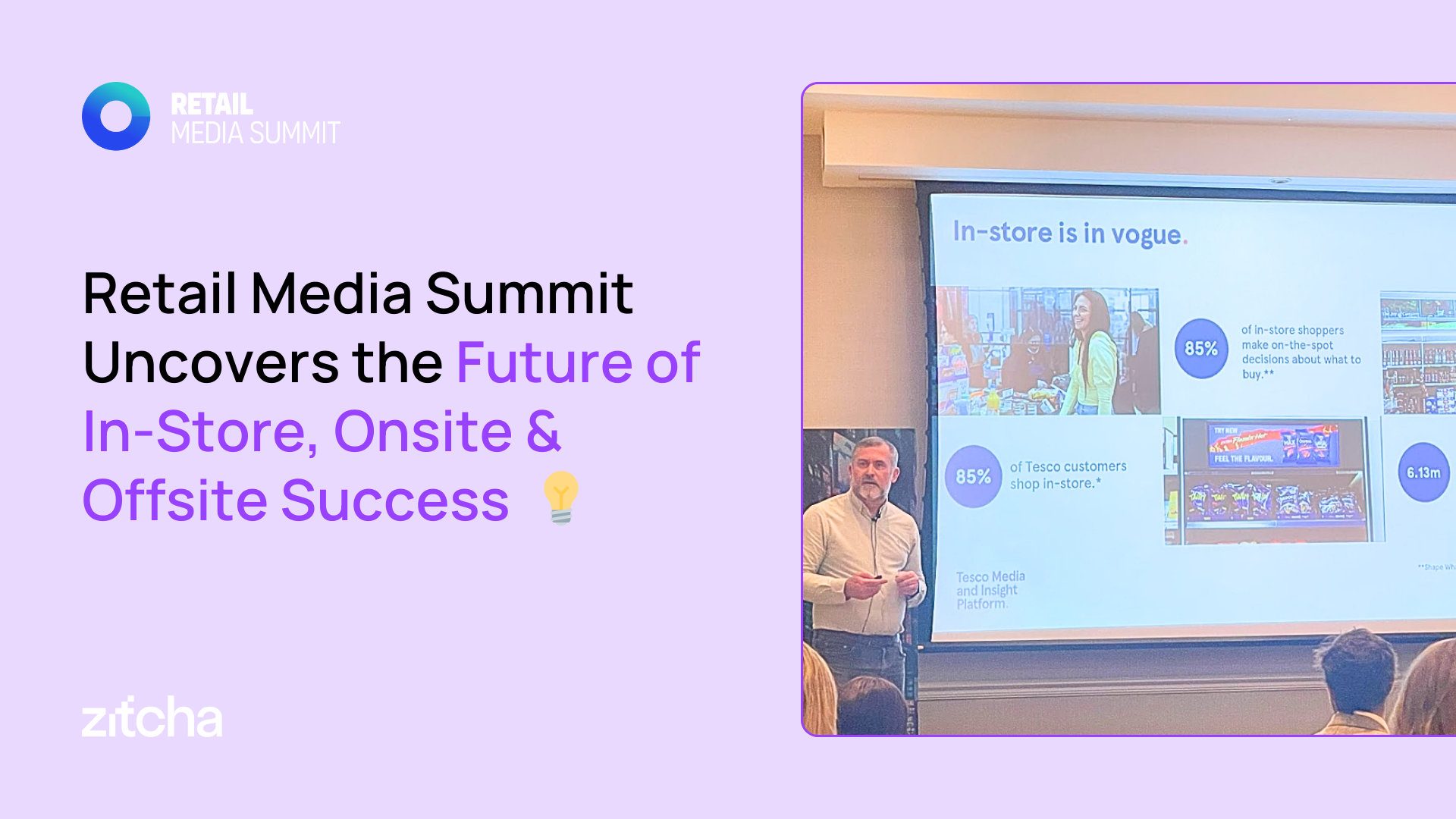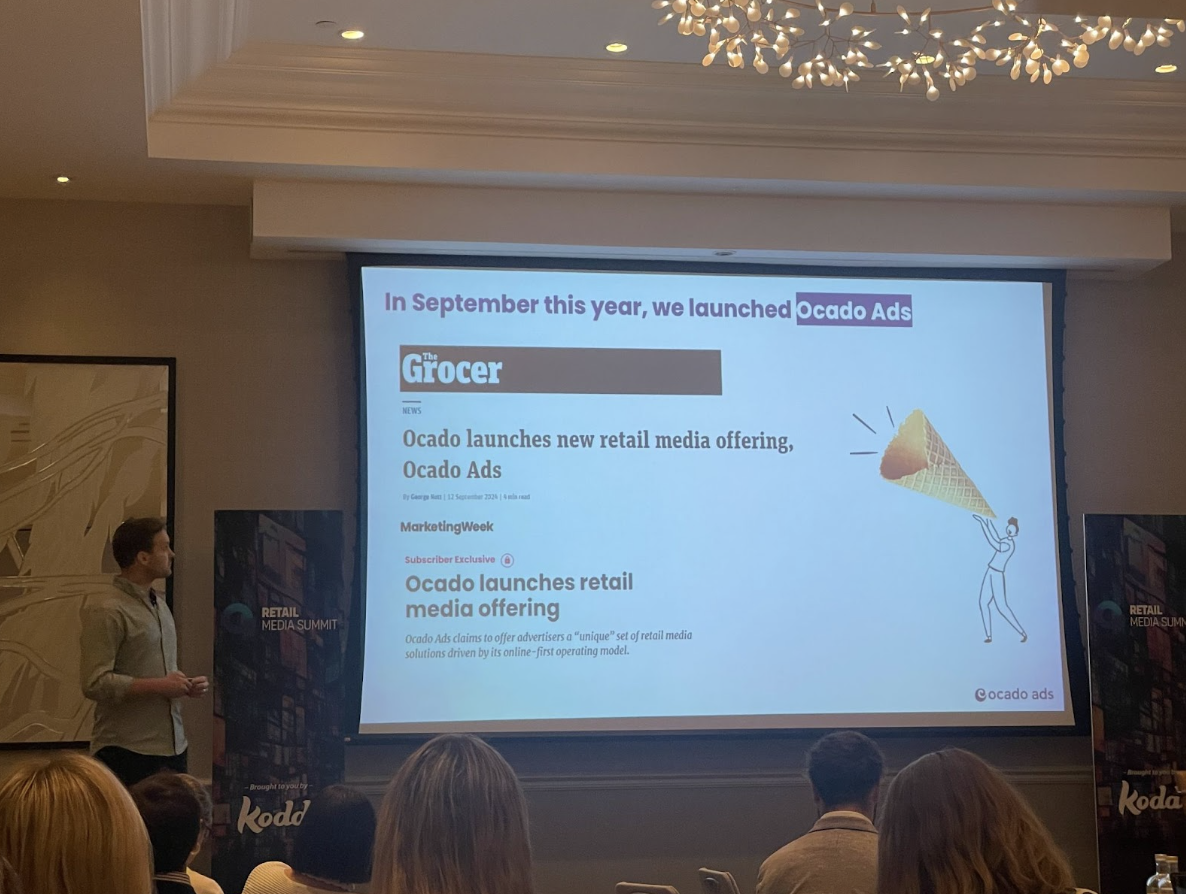

The first Retail Media Summit, hosted on November 14th, brought together top voices in retail media to discuss emerging trends, innovations, and effective strategies. The event highlighted how in-store, on-site, off-site, and unified retail media approaches can unlock revenue potential and support retail growth. Here’s a closer look at the key takeaways from the event, providing an industry-wide perspective on what’s shaping the future of retail media.
In-Store Innovation: Scaling Digital Engagement
A significant focus of the summit was on in-store media, with Nick Ashley from Tesco Media and Insights presenting Tesco’s progress in building a connected store environment. Through the expansion of digital touchpoints, including POS, radio, Scan n Go, and in-store digital screens, Tesco saw touchpoints grow from 500 to over 4,000 within 18 months. These touchpoints deliver measurable impact, contributing to a 7% sales lift and 4% brand uplift, indicating the potential of in-store media to drive both performance and brand engagement.
Alison Dunham from Stratache emphasized the importance of viewing the store as a purchase funnel, with different areas serving distinct purposes. For example, the high-foot-traffic areas at the front of the store can drive customers to low-volume or underperforming sections within a store, while specific locations can serve as zones for educational and informational content rather than purely offer-led promotions. This approach reflects a broader strategy to optimize the physical retail environment and leverage it for diverse objectives.
The panel also touched on how stores historically acted as community hubs, sometimes hosting "stores within a store." This concept, which was once central to retail, appears to have diminished over time. Several speakers suggested that reintroducing this community-centric approach could unlock new engagement opportunities.
Anne Sassi from SOK also pointed to a shift away from traditional print, affirming that digital screens will increasingly play a central role in the in-store experience, creating dynamic and measurable touchpoints.
On-Site Personalization: Meeting Customers with Relevance
On-site media was another key theme, with speakers emphasizing the importance of personalization in retail media networks (RMNs). Carlos Paulo from Endless demonstrated how personalizing ads to reflect customer preferences—like promoting instant coffee to one customer known for only buying instant and coffee pods to another—can significantly increase engagement and relevancy. Loyalty apps also play a critical role here, offering retailers an opportunity to create a more personalized ad experience through targeted ads, coupons, and gamified interactions.
The conversation also touched on evolving measurement needs. Courtland Dearing from Douglas Marketing Solutions noted that brands are moving toward metrics like incremental ROAS (iROAS) to better assess on-site ad impact, as traditional reach and conversion metrics may not fully align with top-of-funnel objectives. This shift underscores the need for RMNs to adapt their measurement capabilities to offer more actionable insights.
Off-Site Media: Aligning Audience and Messaging
Off-site media emerged as a key topic, with speakers stressing the importance of precise targeting and aligning creative messaging with the audience. Alice Anson from Nectar360 shared practical examples of tailoring messaging to shopper personas—highlighting product USPs like organic certifications for high-value shoppers rather than focusing on pricing. The conversation also explored the cost-effectiveness of retail media networks (RMNs) for targeted campaigns. Josh Clarkson from Mars raised concerns about the premium costs of RMNs, which can be 4–10x higher than direct off-site channels like Meta or Google. While RMNs offer highly specific audience targeting, their value must be justified through measurable outcomes such as engaging lapsed shoppers or capturing niche segments.
A notable discussion point was the role of agencies. Speakers emphasized that if RMNs want to secure brand budgets from agencies, they need to better understand the agency ecosystem. They argued that RMNs should adopt practices akin to traditional media owners, including understanding the media agency structure and how to navigate it. Many agencies noted that few if any RMN had ever reached out to them,, underscoring the need for improved collaboration between RMNs and agency teams to unlock brand budgets.
Bringing It All Together: The Power of a Unified Solution
Jack Johnson from Ocado Ads unveiled their new retail media platform, powered by Zitcha, which allows brands to self-serve, access unique audiences, and align their campaigns with Joint Business Plans (JBPs). This approach demonstrates the growing demand for integrated platforms that simplify retail media operations and make campaign data actionable.
Maurits Priem from AD Retail Media emphasized that retail media isn’t just about driving conversions—it also plays a key role in brand building. He shared that cross-media campaigns deliver an average 21% sales uplift and 15% brand uplift, proving that a unified approach can amplify both performance and upper-funnel goals. By integrating retail media across channels, retailers can deliver a cohesive customer experience while unlocking incremental opportunities for advertisers.
Key Takeaways for Retail Media Strategy
- In-Store Media is Evolving: Digital touchpoints are transforming in-store experiences, bridging the gap between physical and digital to deliver measurable sales and brand results. Viewing the store as a purchase funnel and using different areas for specific objectives can maximize impact.
- On-Site Media Needs Personalization: Tailoring ad experiences and expanding personalization through loyalty apps helps retailers connect with customers meaningfully.
- Off-Site Media Requires Strategic Alignment: Effective off-site campaigns depend on precision targeting, creative messaging, and a deeper understanding of agency structures to justify RMN costs and win brand budgets.
- Unified Solutions Drive Results Across Channels: Integrated retail media platforms, such as Zitcha, highlight the power of combining data-driven insights and operational simplicity to achieve both brand and performance objectives.
The Retail Media Summit underscored the importance of tailoring strategies to meet the evolving needs of retailers and advertisers. As the industry grows, unified solutions that integrate in-store, on-site, and off-site channels will play a pivotal role in shaping the future of retail media.
Ready to explore how unified retail media solutions can transform your business? Book a demo today to see how platforms like Zitcha simplify operations, improve collaboration, and unlock new revenue opportunities across in-store, on-site, and off-site channels.



